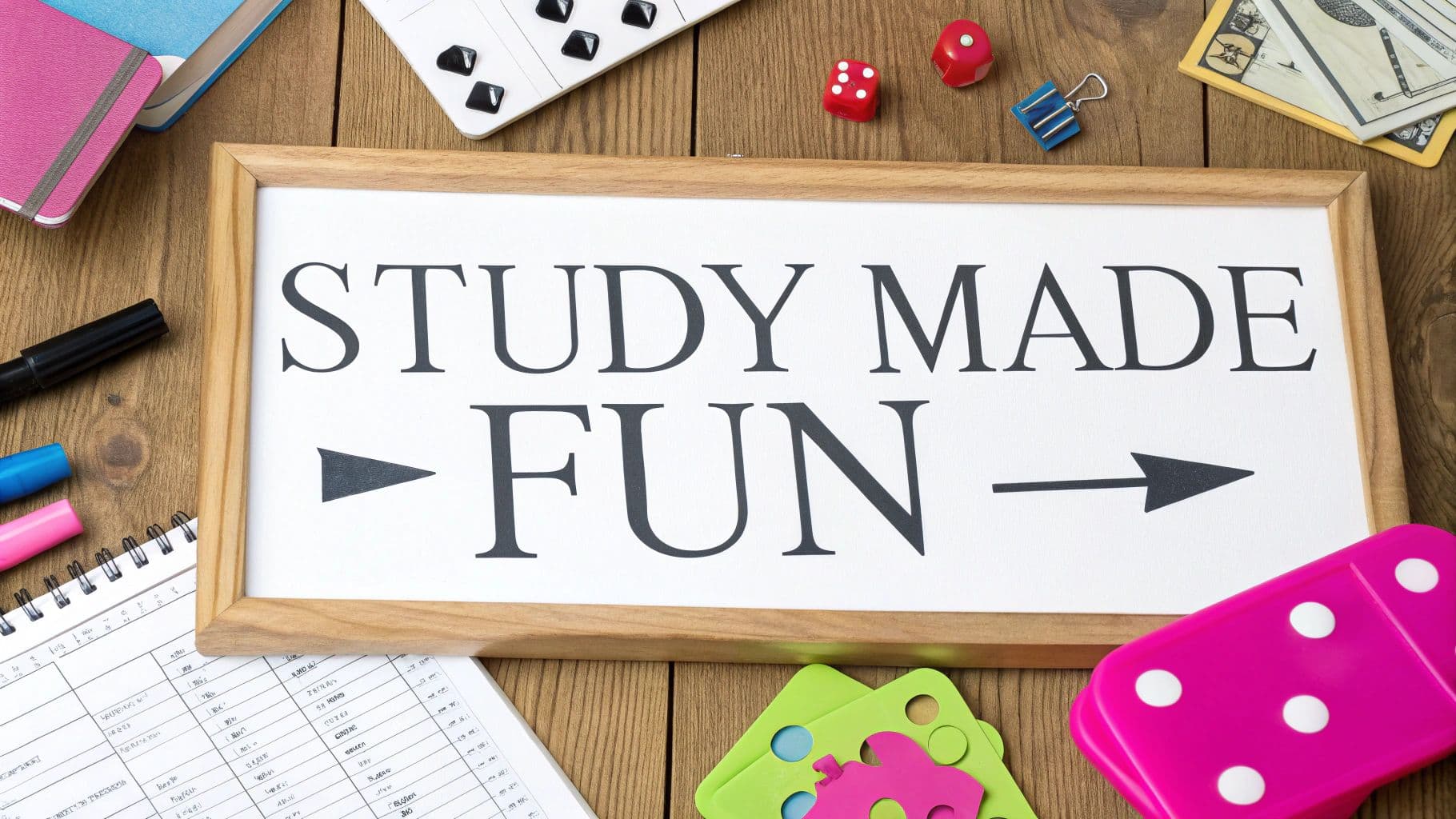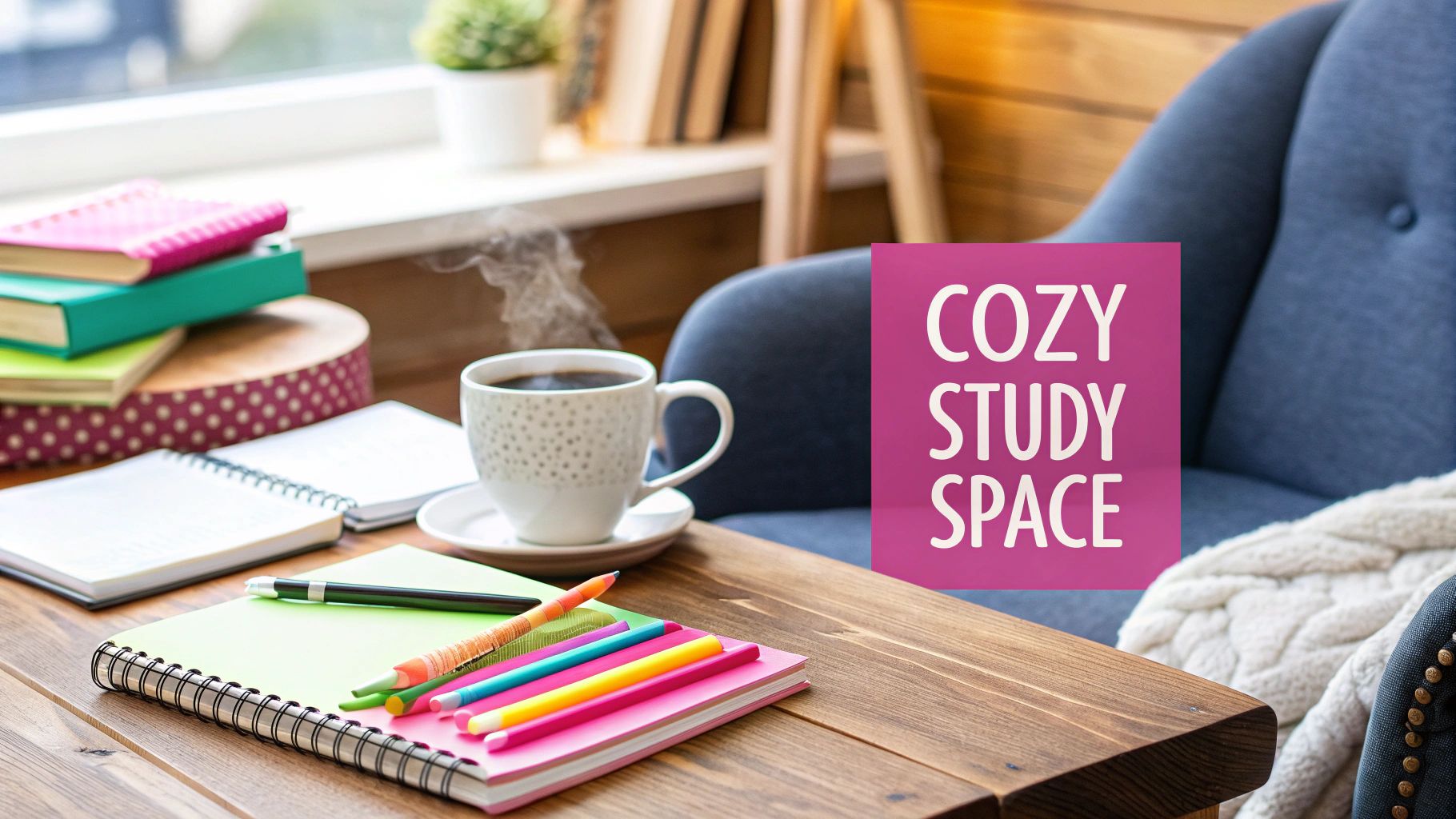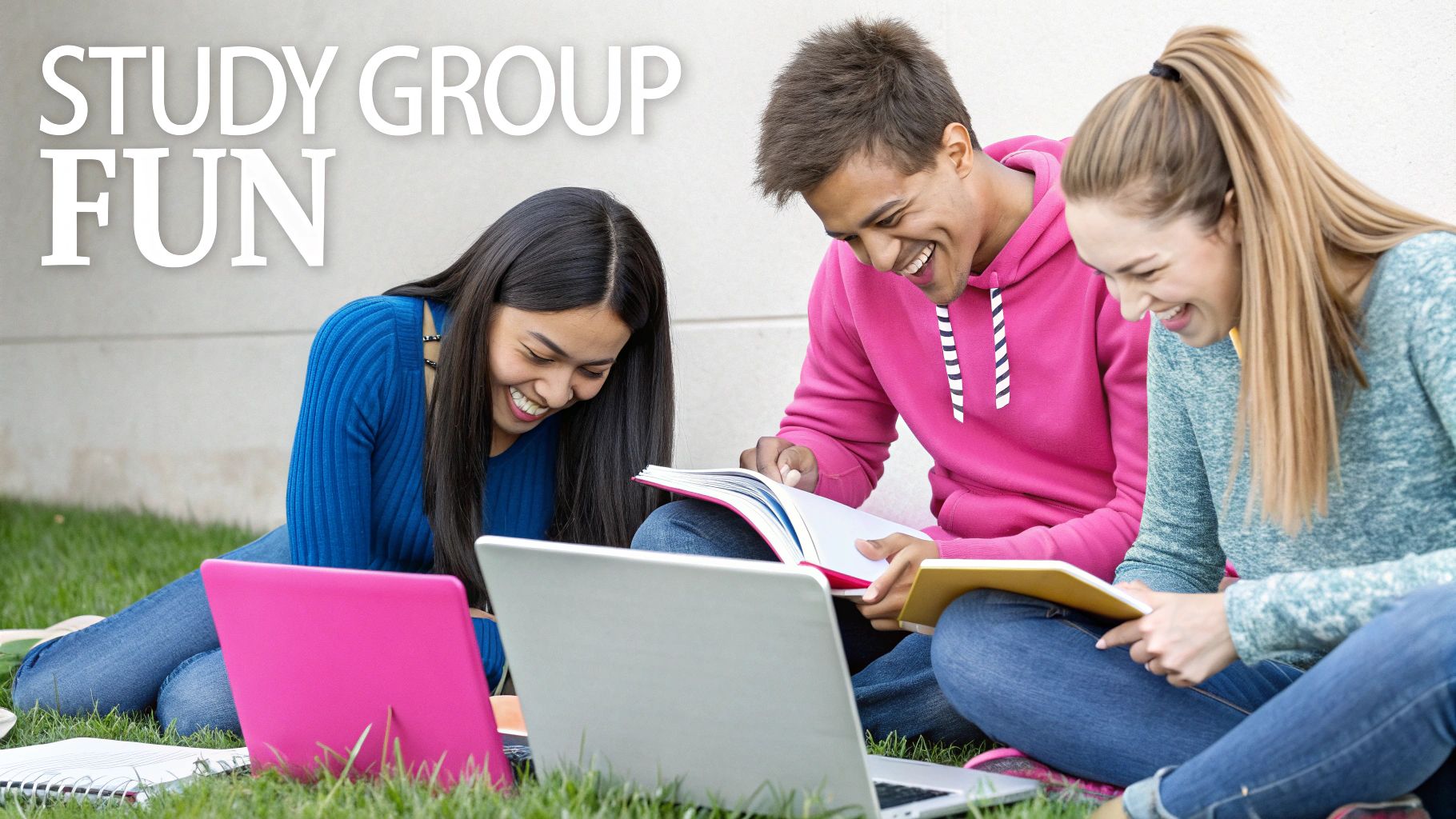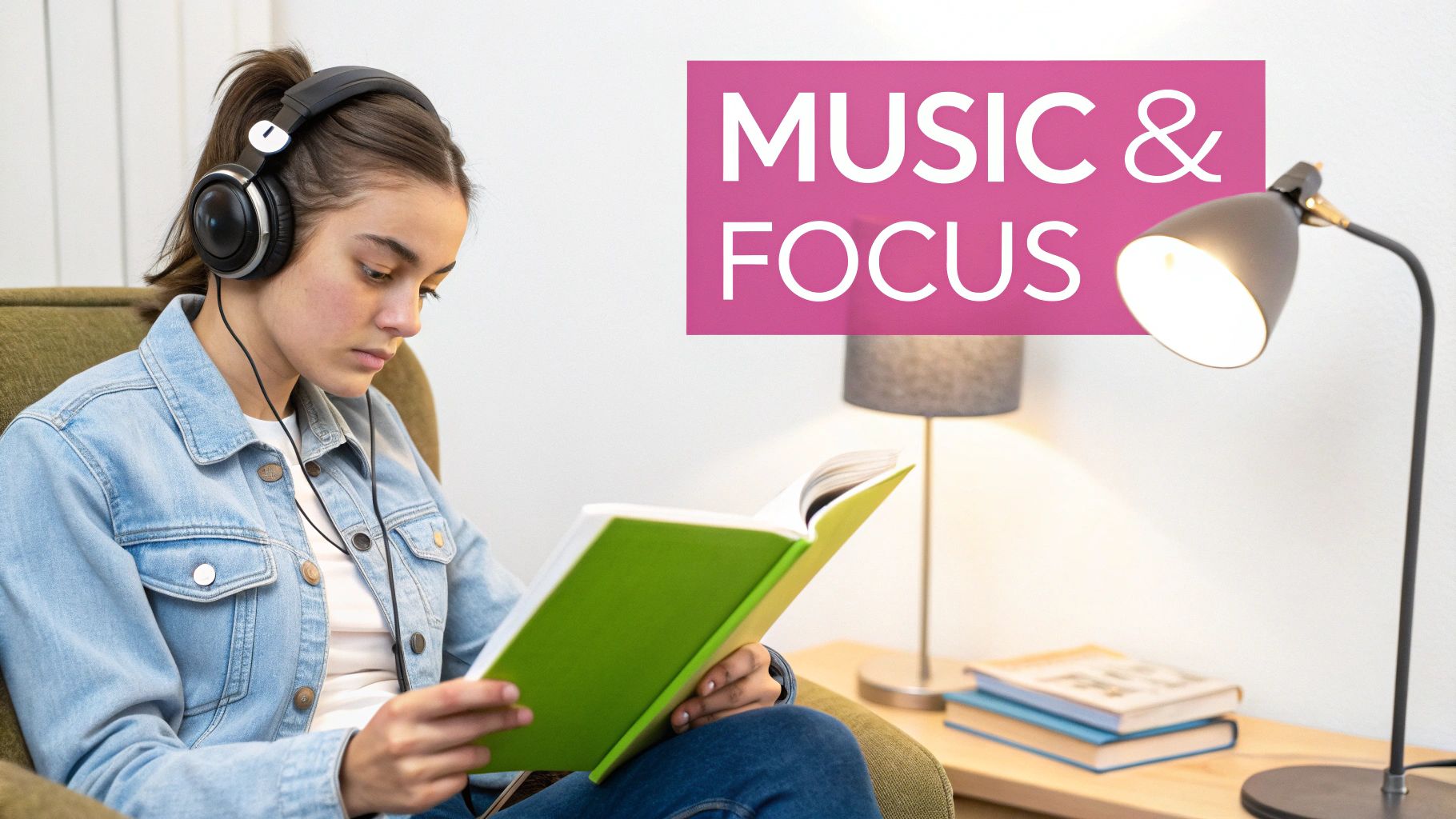
How to Make Studying Fun: A Proven Guide to Transforming Learning
Transform Tedious Topics Through Strategic Gamification

Studying doesn't have to be boring. While you can't make every study session entertaining, you can make learning more engaging by applying game principles to your study routine. This approach, known as gamification, taps into natural human motivations like competition and achievement to make studying more effective and enjoyable.
Channel Your Competitive Spirit: Game-Based Study Methods
Competition can drive us to improve, even when we're only competing against ourselves. Try setting up personal challenges – for example, time yourself completing practice questions and work to beat your previous records for speed and accuracy. This not only makes studying more engaging but helps pinpoint areas where you need extra practice.
Many educational apps and websites now offer subject-specific quizzes with leaderboards and achievement badges. For instance, you can track your progress against other students, creating friendly competition that motivates deeper learning. The social aspect of comparing scores and achievements with peers adds an extra layer of motivation to master the material.
Small Wins Lead to Big Results
Simple rewards can be powerful motivators when studying. After finishing a challenging chapter, take a short break to listen to your favorite song or enjoy a healthy snack. These small rewards help reinforce good study habits without requiring elaborate incentives.
Visual progress tracking also provides concrete evidence of your achievements. Whether you use a simple paper checklist or a digital study planner, marking off completed tasks gives you a clear view of how far you've come. Seeing your progress mapped out can boost motivation and help maintain momentum through difficult topics.
Group Learning Adds Social Energy
Learning alongside others can transform solitary studying into an interactive experience. Study groups introduce opportunities for friendly competition and collaboration that make learning more dynamic. Quiz each other on key concepts, explain difficult topics to peers, and work through problems together. Research shows that students who participate in gamified group learning often perform better on tests compared to those using traditional study methods alone.
Teaching others is particularly effective for deepening your own understanding. When you explain concepts to classmates, you must organize the information clearly and identify any gaps in your knowledge. This process of teaching reinforces learning in ways that passive studying cannot match. By combining social interaction with gamified elements, group study sessions can significantly boost both engagement and retention.
Building Real-World Connections That Stick

Real mastery of any subject comes from connecting classroom concepts to practical, real-world applications. When you can relate what you're studying to your own experiences and daily life, learning becomes both more meaningful and enjoyable. Consider how history lessons become more engaging when you can visualize past events or connect them to current affairs. This kind of active engagement helps cement knowledge in your memory.
Connecting the Dots: Strategies for Different Subjects
Each subject offers unique opportunities for real-world connections. In math and science, try applying formulas to everyday scenarios – like using the Pythagorean theorem to measure spaces in your home. For history students, reading personal letters and diaries from historical figures brings past events to life in a vivid way. Visiting museums or historical sites takes learning beyond textbook pages, creating lasting impressions through direct experience.
Making It Personal: Linking Studies to Your Interests
Learning becomes naturally engaging when you connect it to topics you already care about. Music lovers studying physics might explore how sound waves create different musical notes. Sports enthusiasts learning biology could study how muscles and joints work together during athletic movements. Finding these personal connections transforms studying from a routine task into an exploration of your interests.
Visualizing and Organizing Connections
Visual tools help strengthen these real-world connections in your mind. Creating mind maps, sketching diagrams, or building concept webs allows you to see how different ideas relate to each other. Using colors and images in your visual notes makes the information more memorable and easier to recall. This hands-on approach to organizing information helps build lasting understanding.
From Textbook to Tangible: Putting Learning Into Action
The most effective way to make studying engaging is through active participation. Join debates about topics from your social studies class, or organize mock trials to understand civic principles in action. When you actively apply concepts rather than just reading about them, you develop deeper understanding that stays with you. This approach turns studying from passive note-taking into dynamic exploration of the world around you.
Creating Your Ultimate Interactive Study Environment
Your study space has a direct impact on how well you learn and remember information. By thoughtfully designing an environment that matches your learning style and incorporates engaging elements, you can make studying both more enjoyable and more effective.
Setting the Stage: Physical Space and Study Style
A focused study environment starts with the right physical setup. Find a dedicated space away from distractions, but make it your own. Add personal touches like plants, artwork, or motivational quotes that inspire you while keeping the area organized and clutter-free. A messy space can make it harder to concentrate and retain information.
Think about how you learn best. If you're a visual learner, set up whiteboards and wall space for diagrams and mind maps. For auditory learners, consider a quiet space suitable for listening to recorded lectures or background music. If you learn through movement, create room to walk around while reviewing material or practicing presentations.
Tech Tools to Amplify Engagement
The right technology can help make studying more interactive and fun. Notescast helps transform written notes into engaging video content, which works especially well for visual and auditory learners. Many apps also offer quiz features and digital flashcards that turn review sessions into games, helping maintain motivation through friendly competition.
Online resources like virtual tours and interactive simulations can also bring subjects to life. History students can explore ancient sites remotely, while science students can conduct virtual experiments. This hands-on digital approach helps you actively explore concepts rather than just reading about them.
Interactive Learning in Action: Examples and Techniques
Here are effective ways to make your study sessions more interactive:
-
Mind Mapping: Connect related ideas visually by starting with a main concept and drawing branches to supporting points. This helps you understand how different topics relate to each other.
-
Visual Aids: Create your own diagrams, charts, and timelines instead of just reading text. Seeing information presented visually can improve recall.
-
Creative Projects: Convert study material into something creative like a song, skit, or comic. This deeper engagement with the content makes it more memorable.
| Technique | Description | Example |
|---|---|---|
| Mind Mapping | Visually organize information around a central concept | Create a mind map connecting characters in a novel |
| Visual Aids | Transform text into diagrams, charts, and other visual representations | Draw a timeline of key events in a historical period |
| Creative Projects | Engage with material through creative mediums like music, art, or writing | Write a song summarizing the plot of a Shakespearean play |
By designing a study space that matches your learning style and using interactive study methods, you can make the learning process more engaging and effective. This personalized approach helps you better understand and remember information while actually enjoying the experience of studying.
Making History and Literature Come Alive

The secret to engaging with history and literature lies in connecting with the human experience behind the facts and stories. Rather than simply memorizing dates and plot points, students who thrive in these subjects approach them as windows into real human lives, emotions, and experiences. When you focus on understanding the dreams, fears, and choices of people from different eras, both learning and retention become natural and enjoyable.
Uncovering the Human Story: Primary Sources and Personal Accounts
Primary sources offer a direct connection to voices from the past. For instance, reading a Civil War soldier's letters home reveals intimate details about daily life in camp, personal fears about upcoming battles, and heartfelt messages to loved ones. These firsthand accounts paint vivid pictures that textbooks alone cannot capture. Similarly, exploring diaries of historical figures shows their private thoughts, internal conflicts, and defining moments. Through these personal narratives, names in textbooks transform into real people with relatable hopes and struggles, making their stories stick in our minds.
Creative Interpretation: Bringing the Past to the Present
Getting hands-on with historical and literary material sparks deeper understanding. You might act out a scene from history, write a song from a character's perspective, or sketch key moments from a story. These creative exercises push you to step into others' shoes and grasp their motivations. Making visual aids like detailed timelines or illustrated story maps helps organize information while highlighting connections between events and themes. By actively engaging with the material, you build lasting mental pictures that make learning both fun and memorable.
Multimedia Approaches: Expanding Your Learning Landscape
Different media formats add rich layers to historical and literary study. Quality documentaries show you ancient Rome's grand architecture or take you inside medieval castles, making distant times feel immediate and real. Historical films, while not always perfectly accurate, can paint vivid pictures of past societies and conflicts. Audio resources like poetry readings and dramatic performances bring written works to life through tone, rhythm, and expression. This mix of learning methods keeps your mind fresh and engaged.
Making Connections: Relevance and Fascination
The most powerful learning happens when you find personal meaning in historical events and literary themes. Look for ways past events mirror current issues or how story characters face timeless human challenges. When you recognize how ambition, love, conflict, and courage shaped both historical figures and literary characters, their experiences become guides for understanding your own life and times. This approach transforms studying from pure memorization into an exploration of human nature and shared experiences. By connecting personally with the material, you'll find yourself naturally drawn into learning more.
Making Learning Relevant Through Modern Culture

When you connect your studies to the culture and media you already enjoy, learning becomes much more engaging and meaningful. Rather than treating entertainment and education as separate worlds, you can find creative ways to bridge them. This makes studying feel less like work and more like exploring topics you're genuinely interested in.
Looking at Today's World Through Academic Eyes
Your coursework gives you valuable tools for understanding what's happening around you right now. For instance, sociology students can examine how platforms like Instagram and TikTok are changing the way people interact and build communities. History students might notice how current political debates mirror conflicts from the past. By applying academic concepts to real situations you care about, you gain deeper insights into both your studies and current events.
Getting Creative with Pop Culture Projects
You can make studying more fun by incorporating your favorite media into academic projects. Film students could break down the visual techniques used in music videos they love. Literature students might explore how themes from classic novels show up in modern song lyrics. These types of creative assignments let you demonstrate what you're learning while engaging with content you actually enjoy. The key is finding authentic ways to connect course material with entertainment you find interesting.
Finding Natural Connections Between Learning and Entertainment
The best way to make studying enjoyable is to spot genuine links between your coursework and your interests. If you're fascinated by a certain time period, watching historical documentaries and dramas can help bring those events to life. Creating themed playlists with music from different eras or literary movements can set the perfect mood for focused study sessions. When you build these bridges naturally, studying transforms from a chore into an engaging exploration that sticks with you.
Real Examples of Culture-Based Learning
Here's how different subjects can connect with modern culture in practice:
| Subject | Pop Culture Connection | Learning Activity |
|---|---|---|
| Psychology | Analyze character development in a popular TV series | Explore psychological theories related to character motivations |
| Economics | Track the impact of viral trends on stock prices | Analyze market forces and consumer behavior |
| Political Science | Discuss current events in relation to political ideologies | Debate the pros and cons of different political systems |
| Literature | Compare classic literature themes to contemporary song lyrics | Write an essay analyzing the shared themes |
These examples show just a few ways you can use modern culture to deepen your understanding and make learning more engaging. The key is actively looking for these connections as you encounter media throughout your day. This turns passive entertainment into opportunities for active learning and growth.
Developing a Sustainable Study System That Sparks Joy
Creating an effective study system isn't about forcing yourself to learn – it's about finding methods that keep you engaged and make progress feel natural. When you build habits that match your personal learning style, studying becomes less of a chore and more of an enjoyable journey of growth.
Designing Your Personalized Study Blueprint
The most effective study approach starts with understanding yourself as a learner. Take time to reflect on how you absorb information best. Do you learn better in complete quiet or with gentle background noise? Are you someone who grasps concepts through images, spoken explanations, or hands-on practice? This self-awareness helps you choose techniques that work for your brain. For instance, if you're a visual learner, turning complex topics into colorful mind maps can make difficult material click.
Breaking large topics into smaller, conquerable pieces is equally important. Instead of trying to master an entire subject at once, focus on understanding one concept thoroughly before moving to the next. This approach builds confidence steadily – similar to how a runner starts with shorter distances before attempting a marathon. Small wins add up to major progress over time.
Incorporating Joyful Learning Strategies
Making studying enjoyable means finding personal connections to the material. If you love music, try relating historical events to songs from those time periods. If art speaks to you, sketch out scientific processes or create visual summaries of literary themes. These personal touches transform dry facts into meaningful knowledge that sticks.
Taking proper breaks is also key to maintaining focus and energy. Research shows that short pauses each hour help information sink in better. Simple activities like stretching, walking around the block, or listening to a favorite song can refresh your mind. Think of these breaks like pit stops during a long drive – they keep you going strong for the full journey.
Building a Support System and Celebrating Success
Learning doesn't have to be lonely. Finding study partners or joining online learning communities can make the process more social and fun. Having others to share challenges and victories with provides motivation and keeps you accountable. Whether it's a weekly study group or just checking in with a friend, social support makes a big difference.
Remember to acknowledge your progress, no matter how small. Treat yourself after finishing a tough chapter, share your wins with friends, or simply take a moment to feel proud of your hard work. These positive moments create good associations with studying and fuel your motivation to keep learning.
By following these principles, you can build study habits that not only improve your grades but also make learning an engaging part of your life. When you match your methods to your natural learning style, break down big goals into manageable steps, and celebrate your progress, studying becomes its own reward.
Transform your study sessions from tedious to terrific with Notescast! Turn your notes into engaging videos and make learning 93% easier. Check it out today at https://notescast.app/
